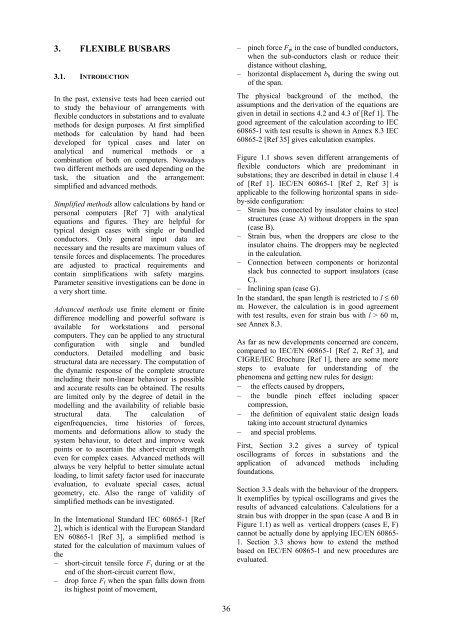The mechanical effects of short-circuit currents in - Montefiore
The mechanical effects of short-circuit currents in - Montefiore
The mechanical effects of short-circuit currents in - Montefiore
Create successful ePaper yourself
Turn your PDF publications into a flip-book with our unique Google optimized e-Paper software.
3. FLEXIBLE BUSBARS<br />
3.1. INTRODUCTION<br />
In the past, extensive tests had been carried out<br />
to study the behaviour <strong>of</strong> arrangements with<br />
flexible conductors <strong>in</strong> substations and to evaluate<br />
methods for design purposes. At first simplified<br />
methods for calculation by hand had been<br />
developed for typical cases and later on<br />
analytical and numerical methods or a<br />
comb<strong>in</strong>ation <strong>of</strong> both on computers. Nowadays<br />
two different methods are used depend<strong>in</strong>g on the<br />
task, the situation and the arrangement:<br />
simplified and advanced methods.<br />
Simplified methods allow calculations by hand or<br />
personal computers [Ref 7] with analytical<br />
equations and figures. <strong>The</strong>y are helpful for<br />
typical design cases with s<strong>in</strong>gle or bundled<br />
conductors. Only general <strong>in</strong>put data are<br />
necessary and the results are maximum values <strong>of</strong><br />
tensile forces and displacements. <strong>The</strong> procedures<br />
are adjusted to practical requirements and<br />
conta<strong>in</strong> simplifications with safety marg<strong>in</strong>s.<br />
Parameter sensitive <strong>in</strong>vestigations can be done <strong>in</strong><br />
a very <strong>short</strong> time.<br />
Advanced methods use f<strong>in</strong>ite element or f<strong>in</strong>ite<br />
difference modell<strong>in</strong>g and powerful s<strong>of</strong>tware is<br />
available for workstations and personal<br />
computers. <strong>The</strong>y can be applied to any structural<br />
configuration with s<strong>in</strong>gle and bundled<br />
conductors. Detailed modell<strong>in</strong>g and basic<br />
structural data are necessary. <strong>The</strong> computation <strong>of</strong><br />
the dynamic response <strong>of</strong> the complete structure<br />
<strong>in</strong>clud<strong>in</strong>g their non-l<strong>in</strong>ear behaviour is possible<br />
and accurate results can be obta<strong>in</strong>ed. <strong>The</strong> results<br />
are limited only by the degree <strong>of</strong> detail <strong>in</strong> the<br />
modell<strong>in</strong>g and the availability <strong>of</strong> reliable basic<br />
structural data. <strong>The</strong> calculation <strong>of</strong><br />
eigenfrequencies, time histories <strong>of</strong> forces,<br />
moments and deformations allow to study the<br />
system behaviour, to detect and improve weak<br />
po<strong>in</strong>ts or to ascerta<strong>in</strong> the <strong>short</strong>-<strong>circuit</strong> strength<br />
even for complex cases. Advanced methods will<br />
always be very helpful to better simulate actual<br />
load<strong>in</strong>g, to limit safety factor used for <strong>in</strong>accurate<br />
evaluation, to evaluate special cases, actual<br />
geometry, etc. Also the range <strong>of</strong> validity <strong>of</strong><br />
simplified methods can be <strong>in</strong>vestigated.<br />
In the International Standard IEC 60865-1 [Ref<br />
2], which is identical with the European Standard<br />
EN 60865-1 [Ref 3], a simplified method is<br />
stated for the calculation <strong>of</strong> maximum values <strong>of</strong><br />
the<br />
– <strong>short</strong>-<strong>circuit</strong> tensile force Ft dur<strong>in</strong>g or at the<br />
end <strong>of</strong> the <strong>short</strong>-<strong>circuit</strong> current flow,<br />
– drop force Ff when the span falls down from<br />
its highest po<strong>in</strong>t <strong>of</strong> movement,<br />
36<br />
– p<strong>in</strong>ch force Fpi <strong>in</strong> the case <strong>of</strong> bundled conductors,<br />
when the sub-conductors clash or reduce their<br />
distance without clash<strong>in</strong>g,<br />
– horizontal displacement bh dur<strong>in</strong>g the sw<strong>in</strong>g out<br />
<strong>of</strong> the span.<br />
<strong>The</strong> physical background <strong>of</strong> the method, the<br />
assumptions and the derivation <strong>of</strong> the equations are<br />
given <strong>in</strong> detail <strong>in</strong> sections 4.2 and 4.3 <strong>of</strong> [Ref 1]. <strong>The</strong><br />
good agreement <strong>of</strong> the calculation accord<strong>in</strong>g to IEC<br />
60865-1 with test results is shown <strong>in</strong> Annex 8.3 IEC<br />
60865-2 [Ref 35] gives calculation examples.<br />
Figure 1.1 shows seven different arrangements <strong>of</strong><br />
flexible conductors which are predom<strong>in</strong>ant <strong>in</strong><br />
substations; they are described <strong>in</strong> detail <strong>in</strong> clause 1.4<br />
<strong>of</strong> [Ref 1]. IEC/EN 60865-1 [Ref 2, Ref 3] is<br />
applicable to the follow<strong>in</strong>g horizontal spans <strong>in</strong> sideby-side<br />
configuration:<br />
– Stra<strong>in</strong> bus connected by <strong>in</strong>sulator cha<strong>in</strong>s to steel<br />
structures (case A) without droppers <strong>in</strong> the span<br />
(case B).<br />
– Stra<strong>in</strong> bus, when the droppers are close to the<br />
<strong>in</strong>sulator cha<strong>in</strong>s. <strong>The</strong> droppers may be neglected<br />
<strong>in</strong> the calculation.<br />
– Connection between components or horizontal<br />
slack bus connected to support <strong>in</strong>sulators (case<br />
C).<br />
– Incl<strong>in</strong><strong>in</strong>g span (case G).<br />
In the standard, the span length is restricted to l ≤ 60<br />
m. However, the calculation is <strong>in</strong> good agreement<br />
with test results, even for stra<strong>in</strong> bus with l > 60 m,<br />
see Annex 8.3.<br />
As far as new developments concerned are concern,<br />
compared to IEC/EN 60865-1 [Ref 2, Ref 3], and<br />
CIGRE/IEC Brochure [Ref 1], there are some more<br />
steps to evaluate for understand<strong>in</strong>g <strong>of</strong> the<br />
phenomena and gett<strong>in</strong>g new rules for design:<br />
– the <strong>effects</strong> caused by droppers,<br />
– the bundle p<strong>in</strong>ch effect <strong>in</strong>clud<strong>in</strong>g spacer<br />
compression,<br />
– the def<strong>in</strong>ition <strong>of</strong> equivalent static design loads<br />
tak<strong>in</strong>g <strong>in</strong>to account structural dynamics<br />
– and special problems.<br />
First, Section 3.2 gives a survey <strong>of</strong> typical<br />
oscillograms <strong>of</strong> forces <strong>in</strong> substations and the<br />
application<br />
foundations.<br />
<strong>of</strong> advanced methods <strong>in</strong>clud<strong>in</strong>g<br />
Section 3.3 deals with the behaviour <strong>of</strong> the droppers.<br />
It exemplifies by typical oscillograms and gives the<br />
results <strong>of</strong> advanced calculations. Calculations for a<br />
stra<strong>in</strong> bus with dropper <strong>in</strong> the span (case A and B <strong>in</strong><br />
Figure 1.1) as well as vertical droppers (cases E, F)<br />
cannot be actually done by apply<strong>in</strong>g IEC/EN 60865-<br />
1. Section 3.3 shows how to extend the method<br />
based on IEC/EN 60865-1 and new procedures are<br />
evaluated.











